M. Isidora Forrest's Blog, page 19
July 10, 2022
A Vision of Isis
In magic, as in life, there are certain experiences that stick with you. This is one of mine.
 Cosmic vision
Cosmic visionThis happened many years ago, and yet it still affects my understanding of the One Who Came to Be Called Isis and, most particularly, the ancient-ancient nature of Her Being. I have never considered it historical truth because—well—it was a vision. Visions tend to be more along the lines of mythic truth, and most particularly, they tend to be mythic truth for the person having the vision. And yet…
I had been doing a series of visions with the Goddess. I asked Her to show me scenes from the history of Her worship—so this was a “watching” vision rather than one I was actively participating in. As the vision began, I knew—in that way that one sometimes just knows in vision—that this scene was to be a very ancient one; even primordial…
 A marsh in the Egyptian delta
A marsh in the Egyptian deltaAnd I am in a green marsh under a hot, noontime sky. Brilliant grasses and reeds wave in a soft, warm, and very humid breeze. Before me, waterways, smooth as glass, wind like serpents through the marsh. The scent of living and dying plants rises and falls on an ancient breeze. “It is the breath of Isis,” I think to myself. Her breath is replete with the lives and the deaths of All Things. Her breath breathes upon me. I take Her breath into my lungs. I taste sharp, green sprouting. I scent moist decay, sweet and sickly. The musk of plant or animal, I am not sure which, is in my mouth.
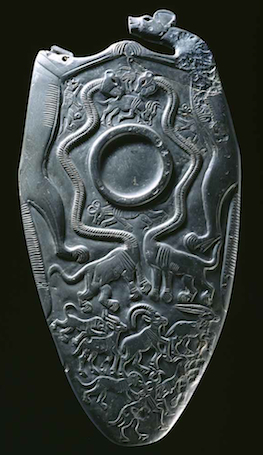 The “two dogs” palette from Hierakonpolis
The “two dogs” palette from HierakonpolisNow my attention turns to the serpentine waterway before me. There is a disturbance beneath the surface. An uprising. Something coming.
Out of that dark water, a tall human figure rises, walking in a bright ecstasy. Her eyes are closed. Her mouth is opened in a slight smile. She is clothed only in the living creatures that accompany Her. A black kite hawk rests on the back of Her neck, embracing the sides of Her head in its wings. Her black hair clings wetly to Her body, falling to Her breasts. Serpents entwine both arms, moving slowly, lovingly. A tusked boar walks on Her left, a crocodile on Her right. They are Her companions, almost pets. Behind Her stride a long-horned cow and bull, along with a trio of playful calves.
As She emerges from the Primordial Water, the Unformed Source, all the creatures of Egypt come with Her. Each one of them is filled with a Divine and ecstatic calm imparted to them by the Goddess. There may be no human beings here at this early, early time; I don’t know. But I do know that this is the Egyptian delta, the holy triangle of wet earth that supports life, where all the rivers diverge as they flow, multi-fingered to the Great Green sea.
 Lady of the Beasts, by Hrana Janto. You can purchase a print here.
Lady of the Beasts, by Hrana Janto. You can purchase a print here.This Goddess, this Isis, is the Lady of the Beasts rising from the Waters. She does not speak to me. She simply shows Herself to me in this way. Her emergence is Creation. Her emergence is Life. Her emergence draws a soft sob of beautiful pain from deep within me.
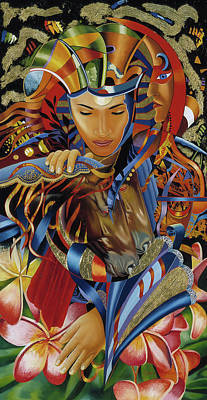 Isis Rising by Graeme Stevenson; you can buy a print here.
Isis Rising by Graeme Stevenson; you can buy a print here.And that is how it went.
As I write it out now, like this, it doesn’t sound very impressive. Yet it was. It hit me hard and strong as Truth. I won’t claim it as historical truth; but for me, it is decidedly mythic Truth. The Divine Power that would eventually be known as Isis, originally coalesced and rose in the Egyptian delta, and particularly as a Goddess connected with animals and the necessary moisture of life.
At this moment, as I write, I am struck by these watery connections. Our Lady of the Waters rises, bringing all living creatures with Her. What’s more, She retains Her connection with life-giving water throughout the millennia. Her Philae temple calls Her “the rain cloud that makes green the field when it descends.” A 2nd century CE papyrus names Her mistress of “all rain, every spring, all dew and snow.” One of the spells in the Greco-Egyptian Magical Papyri says, “I am Isis, called dew.” A calendar in the Rhind Mathematical Papyrus marks the epagomenal day of Her birth as, “Birth of Isis: the Heavens rained.” And Plutarch in his essay On Isis and Osiris relates that Isis was supposed to have been born very near to the moist places. So…the delta.
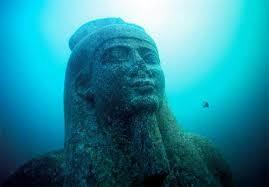 Beneath the waters on the Egyptian coast
Beneath the waters on the Egyptian coastAnd while it hasn’t been established for certain, it may well be that Isis’ worship did first develop in the Egyptian delta. In the Pyramid Texts, She and Osiris are to proclaim the king’s resurrection in the delta, while Nephthys and Set are to proclaim it in Upper Egypt.
The Lower Egyptian location that Isis has been most connected with is the area around ancient Sebennytos, for not far from that town are the ruins of the temple of Isis at Isiopolis (now Behbeit el-Hagar). You can read about it here. But those ruins are quite late—from the 30th dynasty of pharaohs who were particularly devoted to Isis. (The delta, being a much wetter land than Upper Egypt, doesn’t preserve artifacts nearly as well.) Then, just a few kilometers from Isiopolis is the city of Busiris, said to be one of the birthplaces of Osiris. So it would make sense that those two neighboring Deities might be connected early on. Herodotus notes the festival of Isis at Busiris as one of the most important in Egypt; it was a festival of mourning for Osiris. And, of course, Isis also became part of the Ennead of Heliopolitan Deities; Heliopolis was located in Lower Egypt just about where the Nile begins to branch into the multiple delta rivers (it’s now in a Cairo suburb).
But the thing is, I didn’t know any of this when I had that vision. And sometimes, just sometimes, that is how it goes.
__ATA.cmd.push(function() { __ATA.initDynamicSlot({ id: 'atatags-26942-62cb2414b5b57', location: 120, formFactor: '001', label: { text: 'Advertisements', }, creative: { reportAd: { text: 'Report this ad', }, privacySettings: { text: 'Privacy', } } }); });July 4, 2022
“I overcome Fate,” Isis as Queen of Fate
 Goddess of Fate & Fortune by Miranda Adria. See her work here.
Goddess of Fate & Fortune by Miranda Adria. See her work here.I have been thinking lately about time—and the times, that is, the [alarming] times in which we find ourselves. What fate brought us to this time and to this place? Is this our destiny? Is there even such a thing as destiny? Are the Deities the architects of our fate? Are we?
If we look to ancient Egypt, we do find a concept of fate or destiny. It is shai (or shau). Like so many ancient concepts, Fate was personified, in this case as the God Shai. Shai comes from a root word meaning to ordain; as in that which is ordained. Often in ancient Egypt, what they thought was ordained was the length of one’s life. And often, this was connected with one or another of the Deities. People prayed that the Deities would lengthen their time on earth.
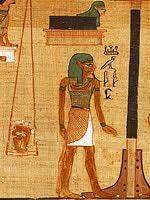 Shai and Meshkhenet at the Weighing of the Heart
Shai and Meshkhenet at the Weighing of the HeartIn some of the Egyptian folk tales we have left to us, the time and sometimes the manner of death is decreed at birth by the Seven Hathors. In the story of the birth of the three kings, the Birth Goddess Meshkhenet is the one Who declares the destiny of the newborn kinglets. The Goddess Renenutet (or Renenet) is also a Destiny Goddess and could decree the prosperity a person might have in life. Shai and Renenutet are sometimes paired as Fate and Fortune or Fate and Destiny.
 A wonderful Renenutet…couldn’t find the artist. Anyone?
A wonderful Renenutet…couldn’t find the artist. Anyone?Those of you who have been following along with this blog won’t be surprised to find that Our Lady of Ten Thousand Names was syncretized with each of these Fate-connected Goddesses.
We already know Her as as Lady Luck. But there is an even more important Isis-Fate connection. And that is, that She is the Ruler of Fate. In Her 1st century CE aretalogy from Kyme in Asia Minor, Isis says, “I overcome Fate. Fate obeys me.” In Egypt, She is called Mistress of Fate (Nebet Shai), Who Creates Destiny; She is Mistress of Life, Ruler of Fate and Destiny. At Aswan, She is “the One under Whose command fate and destiny is.”
 Iset-Renenutet or Isis Thermouthis
Iset-Renenutet or Isis ThermouthisInterestingly, sometimes the hieroglyphs for shai were determined (that is, they have another glyph at the end that gives the overall sense of the word) with the sign for either “death” or “time.” Surely this is because of the Egyptian connection between one’s fate and the time of one’s death. We already know Isis is connected with death and the otherworld. But She is also a Goddess of Time.
This is most easily seen when She is Iset-Sopdet or Isis-Sothis. As I write this, it is summer and the star of Isis, Sirius, is absent from the night sky. It will be some time before I can see Her rise before the sun in the dawning light.
As Isis Sothis, Isis controlled the time of the seasonal, all-important Nile Inundation by the rising of Her star. She is also connected with the timekeeping Egyptian decans, which are 36 stars or smaller groups of stars (asterisms). As the earth turns, each decan is visible for a period of about ten days (or 10 degrees of a 360-degree circle), after which another one rises, marking 360 days of the year. To get to 365, the Egyptians added the five epagomenal days that were “outside” of the year—and during which the birthdays of Osiris, Horus, Set, Isis, and Nephthys were celebrated. In addition to their yearly timekeeping, tracking the decanal stars and asterisms through the night sky served as a star clock for the Egyptians as they counted off the twelve Hours of the Night.
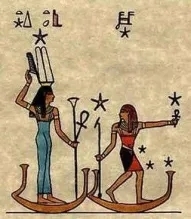 Isis-Sothis & Sah (Osiris) as stars
Isis-Sothis & Sah (Osiris) as starsI’ve seen two different Egyptian names for the decans (decan is Greek for “a tenth”): baktiu and ankhiu. Baktiu, means “those who work” because, when it rose, each decan was said to be “working.” Ankhiu, as you might guess, means “living ones” because, as it rises, each decan is considered to be born. Iset-Sopdet is the first of the decans. Her heliacal rising just before the sun marks the beginning of the New Year. She leads and rules them all.
The Queen of the Decans is also the year as a whole, including what happens within that year. In Memphis, Isis-Hathor is called Renpet, the Year. One of the Oxyrhynchus papyri records one of the names of Isis in the Greek port city of Leuce Acte as Eseremphis, which is a Hellenized version of Iset Renpet. As the Year Itself, Isis decrees what fate each year brings. Horapollon, writing a late work on the meaning of hieroglyphs, says,
When the Egyptians want to represent the year they draw Isis, that is, a woman. And they signify the goddess in the same way. And among them, Isis is a star, called Sothis by the Egyptians, by the Greeks the Dog Star, which appears to rule over the other stars. Now greater, now less as it rises, and now brighter, now dimmer. And according to the rising of this star, we note how everything during the year is going to happen. Wherefore it is not unreasonable to call the year Isis.
Horapollon, book 1, entry 3
 Decan Deities from Denderah
Decan Deities from DenderahThe temple of Ptah at Memphis was known (among other names) as “the Balance of the Two Lands.” The devotees who inscribed the Isis aretalogy at Kyme, in which Isis declares that She overcomes fate, wrote that they had copied it from a stele that stood in front of the Memphis temple of Hephaestos, that is, Ptah. German Egyptologist Heinrich Brugsch commented in his thesaurus of Egyptian inscriptions that the Egyptian New Year’s festival was “the great festival at which the whole world is brought into balance, when the birth of Isis takes place.”
 From our friends at The Motherhouse of the Goddess
From our friends at The Motherhouse of the GoddessDuring the period of Roman rule in Egypt and across the Roman empire, people were feeling particularly pressured or bound by Fate. Astrology had gained general popularity, yet people felt constrained, not enlightened, by “their stars.” So we can easily understand the appeal of a Goddess Who, as the Kyme aretalogy says, regulates the pathways of the stars and orders the course of the sun and moon—and Who also frees those who are in chains.
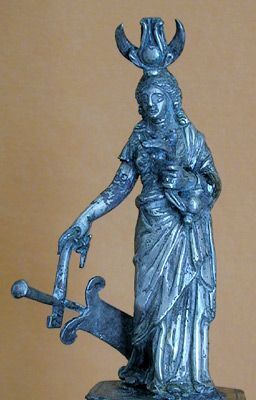 A Roman image of Isis Fortuna
A Roman image of Isis FortunaWe find all these themes in Apuleius’ story of initiation into the Mysteries of Isis. When he comes into Her service, Lucius is freed from his asinine state (he had been turned into a donkey). Isis, a Goddess of Fortune Who sees, replaces the Blind Fortune that had been tossing Lucius to and fro. Instead of implacable Fate, he is now allied with Invincible Isis, Victorious Isis, Triumphant Isis—Isis Who is Providence Itself.
As She always has been, Isis is Nebet Ankh, Henut Shai yt Renenet, Mistress of Life, Ruler of Fate and Destiny. And perhaps in these unsettling times, we too need a Goddess Who can overcome Fate…or help us to do so ourselves.
And so, let us commune with Isis—invoke and make offering to Her. Let us work magic under Her wings and then work in the world toward a better destiny for us all.
June 28, 2022
Isis in Tel Ashkelon
I was out of town last weekend, so sorry, no post. But here’s a bit of news to tide us over until next weekend.
Some marble images—including one of Our Lady, Isis—have recently be placed in a National Park in Israel…and have been displayed in a very clever way.
 I think Isis-Tyche is the second image from the left; and She has kept Her head!
I think Isis-Tyche is the second image from the left; and She has kept Her head!Read more about the images here.
 Here’s where Ashkelon is located
Here’s where Ashkelon is located
June 19, 2022
Isis & Sacred Images
Have you ever had to answer questions explaining all those images on your altar to some folks? You know. The idolatry question?
 My sacred-image-filled Isis shrine. We sacrificed a double closet to give Her this space.
My sacred-image-filled Isis shrine. We sacrificed a double closet to give Her this space.If you’ve ever found yourself in that situation, you probably ended up saying sometime like, “I don’t worship the statue. I worship the Deity represented by the statue.” It seems so simple and obvious. And it is. For the most part.
But when it comes to ancient Egyptian tradition, things do get a bit more interesting.
As you probably already know, images were extremely important in Egyptian tradition. Images, and most especially the sacred images of the Deities, could become vessels for the indwelling of the Divine presence.
 My other enlivened Isis image; She was one of my first
My other enlivened Isis image; She was one of my firstThe sacred image provided a way for the Deity to be physically present in the material world. Jeremy Nadler, one of my favorite writers on the subject, says in his Temple of the Cosmos, “The gods could not be distinguished from their statues or images, and to have done so would have been as false to the ancients as it would be questionable for us moderns to distinguish between a person and his or her body.”
And even then, it wasn’t quite so simple as that. The presence of the Deity in Their statue wasn’t constant. Instead, the presence—usually as the ba, but sometimes as the ka—had to be invoked and re-invoked. When this happened, we usually hear the Egyptians saying that the Deity inhabits the image or unites Their ba with the image so that it becomes “ba-full.”
According to Louis Žabkar, an American Egyptologist who has produced one of the most important studies of the ba, the daily ritual in the temples was to join the Divine bas to Their images. And there were other rites at other times meant to do the same thing. The Divine ba is envisioned as swooping down on the sacred image from the heavens, like a bird, to unite with the image.
And the Egyptians weren’t the only ones to hold Divine images as enlivened. In Apuleius’ tale of initiation into the Greco-Roman Mysteries of Isis, he tells us that he repeatedly stood before the temple statue of the Goddess and worshiped Isis in Her image. “I was rapt in my gaze on the image of the Goddess,” he writes. Later in the story, he describes a deeply emotional experience he has had while praying before the statue. “I laid myself down at last in obeisance before the Goddess and for a long time wiped Her feet with my face. Then, with welling tears, breaking my speech with frequent sobs and swallowing my words, I addressed Her.” In describing an earlier procession of the Goddess, Lucius mentions the images carried by special bearers and which he calls “breathing effigies.” Very much in the Egyptian tradition.
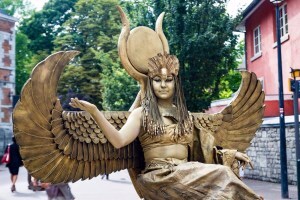 An actual breathing effigy
An actual breathing effigyThe idea that an aspect of the Divine can become attracted to and activated in a special image passed into Renaissance Europe via the Hermetic tradition; a tradition deeply rooted in Egyptian as well as Greek philosophy. The Qabalistic tradition handed down the idea of the golem, a being made from clay that the Rabbis activated by prayer and ritual. In alchemy, the homunculus, or “little man,” is a similar concept. The idea that certain images can be enlivened or charged by the Divine comes into modern magical religions as talismanic magic in which special symbols and images (talismans) can be consecrated with Divine energy. The word talisman comes from the Greek for a perfect or completed object; thus it would be quite reasonable to think of your sacred images as talismans.
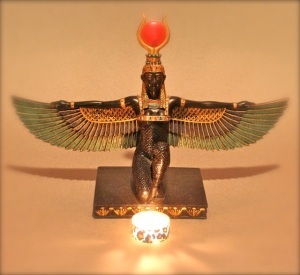 Another favorite, but this one hasn’t been enlivened. Yet, anyway.
Another favorite, but this one hasn’t been enlivened. Yet, anyway.Some cultures believe that God, the Deities, or the Divine Spirit is contained within all things. These animistic, pantheistic, or panentheistic cultures understand the world as brilliantly alive and sacred. On this subject, the Greek philosopher Plotinus wrote, “there is nothing which is without a share of soul.” Iamblichus, a Neoplatonist philosopher, joined him in finding the world alive, ensouled, and sacred declaring, “as to the first principle, that the gods dwell only in heaven, it is not true. Everything is full of them.” Many indigenous cultures, too, share this view, as do many modern Neo-Pagans, Polytheists, Wiccans, Goddess devotees, and more. If we accept this, then even the materials with which our sacred images are constructed contain a bit of the Divine within. And they will only be more powerful when specifically activated to receive an influx of the Divine.
The large image of Isis that sits upon my altar as well as the small golden one above have both been enlivened through ritual and invocation. (Isis Magic includes a ritual for enlivening your own sacred image in the Magician chapter, if you are so inclined.) As living images they serve as a focus for my meditation and prayer. I can feel Her in the image, especially if I have been spending a lot of time in the shrine with Her. I honor that spark from the heart of the Goddess, or perhaps Her ba, that resides within this sacred image. The image is a focus for prayers and a conduit for the blessing of the Goddess. The spark within it lights the fire of love for the Great Goddess Isis—Whose image is at once everywhere and nowhere.
 My large, enlivened Isis in Her outdoor temple __ATA.cmd.push(function() { __ATA.initDynamicSlot({ id: 'atatags-26942-62af6004f3330', location: 120, formFactor: '001', label: { text: 'Advertisements', }, creative: { reportAd: { text: 'Report this ad', }, privacySettings: { text: 'Privacy', } } }); });
My large, enlivened Isis in Her outdoor temple __ATA.cmd.push(function() { __ATA.initDynamicSlot({ id: 'atatags-26942-62af6004f3330', location: 120, formFactor: '001', label: { text: 'Advertisements', }, creative: { reportAd: { text: 'Report this ad', }, privacySettings: { text: 'Privacy', } } }); });
June 12, 2022
S***ter Beware!
Today’s post is short as I have my head and keyboard buried in working on a talk I’m preparing for another part of my magical life. Enjoy. I snorted when I found this out…
 This image is not AT ALL what I thought it was
This image is not AT ALL what I thought it wasThis is a lesson in not seeing what’s right before your eyes. (For me, I mean.)
I have seen this image, well, forever. But I never knew what it actually was. As far as I was concerned, this was just a Roman fresco of Our Lady Isis as Isis-Fortuna, complete with Her requisite steering rudder and cornucopia of plenty. I never knew what the tiny, naked human flanked by either helpful or dangerous snakes (not sure which) was supposed to be doing.
The Goddess is indeed Isis. And the tiny, naked human is taking a crap.
Yep.
 An excavated Roman public toilet; it wouldn’t have been this clean
An excavated Roman public toilet; it wouldn’t have been this cleanThis image comes from a Roman public toilet. The Latin above it says “cacator cave malu(m).” It means “shitter, beware the evil.” So Isis-Fortuna is there to protect anyone using the public toilet because anytime they used one, they were exposing themselves to a whole lotta evil infection and parasites and general uncleanliness. I’m not going to go into the yuck (though there’s plenty of yuck to ancient Roman public toilets). That’s not the point.
The point is, you’ve always got to look deeper and understand the context…because it’s not always obvious.
That said, I hope Isis was able to help keep the evil away from all those ancient shitters.
June 5, 2022
Isis in All Her Names
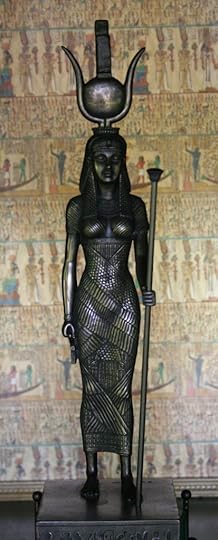 Isis, the Myriad-Named One
Isis, the Myriad-Named OneIn ancient Egyptian, there was a phrase that expressed the all-encompassing nature of Isis: Iset em Renu Nebu, “Isis in All Names.” By later periods of Her worship—within Egypt as well as throughout the Mediterranean world—Isis was understood as an All-Goddess Who could be seen in many other Goddesses. Her multi-faceted nature was expressed in a vast array of epithets attesting to Her Divine powers.
When we enter into a relationship with a Deity, that Deity will inevitably expand for us as we learn more about Them and develop our understanding of Them. Perhaps we first greet Isis as protectress of Osiris and mother of Horus. But then we discover that Her power to do those things is because She is, first and foremost, Great of Magic. As we grow our relationship, She reveals more of Herself to us, She opens more doors to Her Divinity for us.
The same thing happened in ancient times. As She revealed ever more of Her Divinity to Her devotees, She became known, in Greek, as Myrionymos, “Myriad Named,” an almost precise echo of Her earlier Egyptian epithet.
So what I have for you today is an invocation of isis in some of those myriad names and epithets. It is from one of the Oxyrhynchus papyri, which date roughly to the beginning of the 2nd century CE. For those who might like to look it up, this specific invocation is in Oxyrhynchus Papyrus XI.1380.
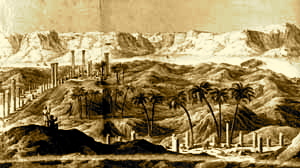 The town of Oxyrhynchus in Egypt in ruins
The town of Oxyrhynchus in Egypt in ruinsBut first, let me tell you a bit about the papyri found in Oxyrhynchus, an ancient Egyptian city about ten days journey by water or five by land south of Memphis. The city was once quite beautiful, with colonnaded streets, temples, docks, and irrigated land out into the countryside. Outside of town were the city dumps. In the dumps, an enormous cache of ancient papyri was discovered. And because it never rains in this part of Egypt, everything that was above ground-water level was preserved, long after the city itself had crumbled to dust or been dismantled and reused as building materials. You’ll find more on the papyri here.
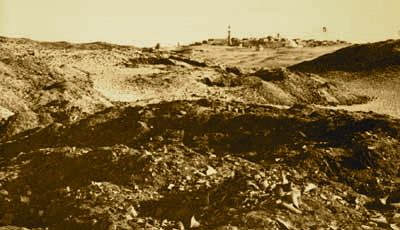 The garbage dumps of Oxyrhynchus, where the papyri were found
The garbage dumps of Oxyrhynchus, where the papyri were foundIn these papyri, we have everything from tax documents to personal letters to books to magical workings and invocations. Blessedly, we have an amazing Invocation of Isis in which She is invoked by Her names and epithets, first in the nomes and cities of Egypt, and then in other parts of the Mediterranean world. The Invocation goes on to offer praises to the Goddess. Scholars think it was written by an initiate of Isis, possibly a priest at Memphis. It was composed in Greek and it ranks as one of the most important Isiac documents ever found. And, of course, a great deal of it is missing. Sigh.
To make it easier to read, I’m going to leave out most of the triple dots (. . .) that indicate places where the papyrus was too damaged to read (except where that doesn’t make sense or is just too intriguing to leave out). Also, I’ll italicize the name or epithet, while leaving the place names un-italicized and break it into paragraphs, something the original does not do. The original was written in Greek, the lingua franca of the time.
The Oxyrhynchus Invocation of Isis the Many-Named Goddess
 The first names are from towns in Egypt
The first names are from towns in EgyptI invoke Thee, Who at Aphroditopolis art called One; Who art called Bubastis; at Letopolis Magna, One; at Aphroditopolis in the Prosopite Nome, Fleet-Commanding, Many-Shaped, Aphrodite; at Delta, Giver of Favors; at Calamisis, Gentle; at Carene, Affectionate; at Niciu, Immortal, Giver; at Momemphis, Ruler, at Psochemis, Bringer To Harbor; at Mylon, Ruler; at Hermopolis, Of Beautiful Form, Sacred; at Naucratis, Fatherless, Joy, Savior, Almighty, Most Great; at Nithine in the Gynaecopolite Nome, Aphrodite; at Pephremis, Isis, Ruler, Hestia, Lady of Every Country; at Es, Hera, Divine; at Buto, Skilled in Calculation; at Thonis, Love; in the Saite Nome, Victorious, Athena, Nymph; at Caene, Joy; at Sais, Hera, Ruler, Perfect; at Iseum, Isis; at Sebennytus, Inventiveness, Mistress, Hera, Holy…
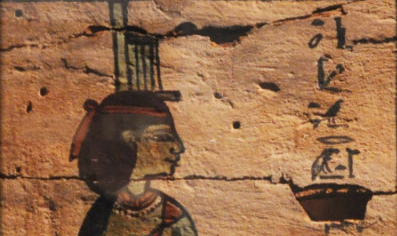 More Greek names for Egyptian towns
More Greek names for Egyptian townsAt Hermopolis, Aphrodite, Queen, Holy; at Diospolis Parva, Ruler; at Bubastus of Old, at Heliopolis, Aphrodite, at Aithribis, Maia, Supporter; at Hiera in the Phthemphuthite Nome, Lotus-Bearing; at Teouchis, Sacred, Mistress; among the Bucoli, Maia; at Xois of Old, Oracular; at Apis, Understanding; at Leuce Acte, Aphrodite, Mouchis [probably “She of Mouchis;” Mouchis was near Aphroditopolis], Eseremphis [Greek version of Egyptian name meaning “Isis the Year”]; at Choatine, Victorious; at …, Skilled in Writing; at Cynopolis in the Busirite Nome, Praxidice [a justice-bringing Goddess]; at Busiris, Fortune, Good; at Hermopolis in the Mendesian Nome, Leader; at Pharbaethus, Of Beautiful Form; at Isidium in the Sethroite Nome, Saviour of Men; at Heracleopolis in the Sethroite Nome, Mistress…
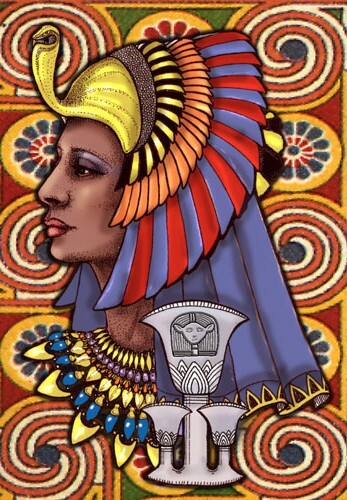 A beautiful image by the artist Zingaia. You can find her on Deviant Art.
A beautiful image by the artist Zingaia. You can find her on Deviant Art.At Phernouphis, Ruler of Cities; at Leontopolis, Serpent, Good; at Tanis, Of Gracious Form, Hera; at Schedia, Inventiveness; at Heracleum, Lady of the Sea; at Canopus, Leader of the Muses; at Menouthis, Truth; at Meniouis, Seated Before Io in Whose Honor . . . Is Founded; at M…Enestium, Most Great, Vulture-Sharped, Aphrodite; at Taposiris, Thauestis [unsure, but may be related to a popular Egyptian name, Thaues or Thauesis, meaning “Of Isis”] Hera, Giver; in the Island, Swiftly Victorious; at Peucestis, Pilot; at Melais, Many-Formed; at Menouphis, Warlike; in the Metelite Nome, Kore; at Charax, Athena; at Plinthine, Hestia; at Pelusium, Bringer To Harbor; in the Casian District Tachnepsis; at the Outlet, Isis, Preserver;
In Arabia, Great Goddess; in the Island, Giver of Victory in Sacred Games; in Lycia, Leto; at Myra in Lycia, Sage, Freedom; at Cnidus, Dispeller of Attack, Discoverer; at Cyrene, Isis; in Crete, Dictynnis; at Chalcedon, Themis; at Rome, Warlike; in the Cyclades Islands, Of Threefold Nature, Artemis; at Patmos, Young; at Paphos, Hallowed, Divine, Gentle; in Chios, Marching; in Salamis, Observer; in Cyprus, All-Bounteous; in Chalcidice, Holy; in Pieria, Youthful; in Asia, Worshipped at the Three Ways; at Petra, Savior; at Hypsele, Most Great; at Rhinocolura, All-Seeing; at Dora, Friendship; at Stratonos Pyrgos Hellas, Good; at Ascalon, Mightiest; at Sinope, Many-Named; at Raphis, Mistress; at Tripolis, Supporter; at Gaza, Abundant…
 Sacred image of Isis from Brexiza, Greece, near Marathon
Sacred image of Isis from Brexiza, Greece, near MarathonAt Delphi, Best, Fairest; at Bambyce, Atargatis; among the Thracians and in Delos, Many-Named; among the Amazons, Warlike; among the Indians, Maia; among the Thessalians, Moon; among the Persians, Latina; among the Magi, Kore, Thapseusis [this name is hard to make out; possibly a specifically Persian name, possibly a magical name]; at Susa, Nania [possibly a syncretic Isis-Innana]; in Syrophoenicia, Goddess; in Samothrace, Bull-Faced; at Pergamum, Mistress; in Pontus, Immaculate; in Italy, Love of the Gods; in Samos, Sacred; at the Hellespont, Mystic; at Myndus, Divine; in Bithynia, Helen; in Tenedos, Name of the Sun; in Caria, Hekate; in the Troad and at Dindyma, Palentra [also unknown], Unapproachable, Isis; at Berytus, Maia; at Sidon, Astarte; at Ptolemais, Understanding; at Susa in the District of the Red Sea, Sarkounis [unknown]…
Thou Who interpretest first of all by the Fifteen Commandments [the word used in Greek is thesmoi, laws; I really want to know what these 15 Commandments or Laws of Isis are—so far, no one does know], Ruler of the World; Guardian and Guide, and Lady of the Mouths and Rivers and of Seas; Skilled in Writing and Calculations, Understanding; Who Also Bringest Back the Nile Over Every Country; the Beautiful Animal [probably, the Cow] of All the Gods; the Glad Face in Lethe; the Leader of the Muses; the Many-Eyed; the Comely Goddess in Olympus; Ornament of the Female Sex and Affectionate; Providing Sweetness in Assemblies; the “Lock of Hair” in Festivals; the Prosperity of Observers of Lucky Days; Harpocratis [possibly an expression meaning something like the “darling”] of the Gods; All-Ruling in the Procession of the Gods, Emnity-Hating, True Jewel of the Wind and Diadem of Life; By Whose Command Images and Animals of All the Gods, Having … of Thy Name, are Worshiped; O Lady Isis, Greatest of the Gods, First of Names, Io Sothis…
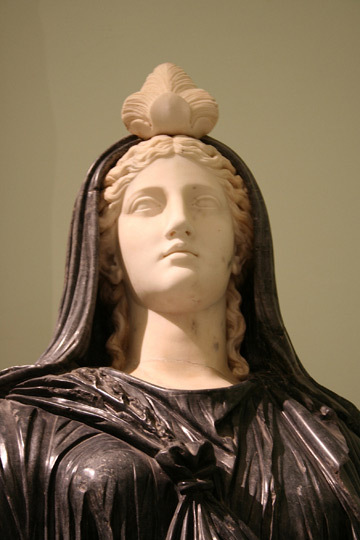 Roman Isis, from the 2nd century CE, in the Farnese Collection in Naples
Roman Isis, from the 2nd century CE, in the Farnese Collection in NaplesThou rulest over the Mid-Air and the Immeasurable; Thou devisest the weaving of . . . ; it is also Thy will that women in health come to anchor with men; all the elders sacrifice; all the maidens at Heracleopolis turn to Thee and dedicated the country to Thee; Thou art seen by those who invoke Thee faithfully; from Whom … in virtue of the 365 combined days; gentle and placable is the favor of Thy Two Ordinances [like the Commandments, I want to know!]; Thou bringest the Sun from rising unto setting, and all the Gods are glad; at the rising of the stars the people of the country worship Thee unceasingly and the other sacred animals in the sanctuary of Osiris; they become joyful when they name Thee; the spirits become Thy subjects; [the next few lines are very fragmentary] and Thou bringest decay on what Thou wilt and to the destroyed bringest increase, and Thou purifiest all things; every day Thou didst appoint for joy; Thou … having discovered all the … of wine providest it first in the Festivals of the Gods.
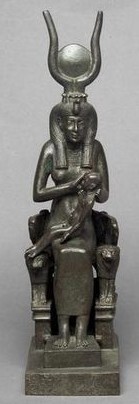 Isis with Horus upon Her lion throne
Isis with Horus upon Her lion throneThou becamest the discoverer of all things wet and dry and cold and hot, of which all things are composed; Thou broughtest back alone Thy Brother, piloting Him safely and burying Him fittingly; Leader of Diadems; Lady of Increase and Decay, Thou didst establish shrines of Isis in all cities for all time; and didst deliver to all human beings observances and a perfect year; and to all human beings in every place, Thou didst show . . . in order that all might know that Thou . . .
Thou didst establish Thy son Horus Apollon everywhere, the youthful Lord of the Whole World and for all time; Thou didst make the power of women equal to that of men; and in the sanctuary Thou didst . . . ; Thou, Lady of the Land, bringest the flood of rivers—in Egypt, the Nile, in Tripolis, the Eleutherus, in India, the Ganges; owing to Whom the whole exists through all rain, every spring, all dew, and snow and all the land and sea; Thou art also the Mistress of All Things Forever; Thou madest the . . . of the Dioscuri; Thou hast dominion over winds and thunders and lightnings and snows; Thou, the Lady of War and Rule, easily destroyest tyrants by trusty counsels; Thou madest great Osiris immortal and delivered to every country religious observances; likewise Thou madest immortal Horus who showed Himself a benefactor and good; Thou art the Lady of Light and Flames… [then the Invocation moves to a praise of Horus, and then it breaks off]
There is much to meditate on here. Perhaps you will be inspired, as I am, to call upon Her in some of these many names—and maybe even add your own to the list. “In Portland, Great of Magic, Queen Isis, Mysterious One…”
__ATA.cmd.push(function() { __ATA.initDynamicSlot({ id: 'atatags-26942-629d2b70ebed3', location: 120, formFactor: '001', label: { text: 'Advertisements', }, creative: { reportAd: { text: 'Report this ad', }, privacySettings: { text: 'Privacy', } } }); });May 29, 2022
Isis and … Aesop?
 Foxy lusting after some juicy, ripe grapes
Foxy lusting after some juicy, ripe grapesDid you know that there’s a connection between the famous teller of tales and Isis? In fact, it’s rather important one, at least for Aesop.
Who was Aesop, again?
First, a quick refresher on Aesop. We’ve all heard his fables—amusing stories, often featuring animals, that teach moral lessons: The Fox and the Grapes, the Ant and the Grasshopper, the Tortoise and the Hare, the North Wind and the Sun, the Boy Who Cried Wolf.
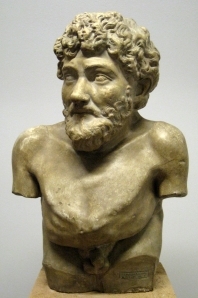 This is the most well known image of Aesop, showing a deformed body, but a sage’s face. This one is a cast in the Pushkin Museum from original in the Art Collection of the Villa Albani, Rome.
This is the most well known image of Aesop, showing a deformed body, but a sage’s face. This one is a cast in the Pushkin Museum from original in the Art Collection of the Villa Albani, Rome.Scholars are far from certain as to whether Aesop actually lived or he was more of a Paul Bunyan or Pecos Bill folk hero. There are a number of versions of the story of his life, which are known as the Life of Aesop or the Romance of Aesop. Today, it’s more often called the Romance, not because it’s about the love life of Aesop, but because it is likely to be mostly fictional. Early fiction novels were known as romances, and yes, many were indeed about star-crossed lovers. (There were romances that included Isis as a character, too, by the way; I write about one of them in Isis Magic.)
If we believe the Life or Romance, Aesop lived from 620 to 564 BCE. He was said to have been a Phrygian or an Ethiopian or to hail from Thrace or Sardis or Lydia (you see?). He is mentioned by Aristotle, Herodotus, and Plutarch, as well as a number of Greek playwrights and poets. He is supposed to have been a slave born with significant physical deformities, but by his wit, wisdom, and skill at storytelling, he came to be a counselor to kings, pharaohs, and sages.
Aesop & Isis
But where did this ex-slave get his gift of gab? According to one version of the Romance (and there are several), in addition to his deformities, Aesop was mute. One day, while he is toiling in the fields, he sees a priestess of Isis who is clearly lost, wandering blindly about in the field where Aesop is working.
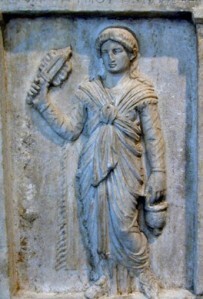 A priestess of Isis of the period
A priestess of Isis of the periodHe goes to help her, gives her refreshments, and shows her the way back to the road. For his kindness and piety in assisting a holy woman, the priestess prays to “Isis of the Many Names” that Aesop will be granted the ability to speak.
Time passes and Aesop settles down in the field for a nap. He dreams. And in his dream, Isis and the Nine Muses appear to him. The Goddess announces that She will give Aesop a voice and asks each of the Muses to bestow upon him a gift from Her own specialty. In addition to those nine gifts, They grant to him “the invention of words, and the weaving and construction of Greek stories.” When Aesop awakes, he finds that he can indeed speak and excitedly begins naming everything he sees. He understands without a doubt that he received this blessing because he had been pious toward the priestess of Isis and he wraps up by telling himself the moral of the tale: “And so it is good to be pious! I expect to receive good hopes from the Gods.”
 Another image of Aesop, chatting with a fox
Another image of Aesop, chatting with a foxBecause of Aesop’s awakening to a new life as a speaking teller of tales and his use of the phrase “good hopes,” some scholars have tried to see in the Romance allusions to an initiation into the Mysteries of Isis similar to that in Apuleius’ famous tale from Metamorphoses. One of the things learned by the Mystery initiates at Eleusis, according to Cicero, was “how to live in joy and to die with better hopes.” Most scholars don’t agree that the Romance supports classification as an initiatory tale. Nevertheless, I find it quite interesting, to say the least, that our romantic Aesop seems to allude to the Mysteries.
Isis & Muses & Words of Power
The Romance was probably written in the 2nd century CE. This places it smack dab in the middle of the height of the worship of Isis in the Graeco-Roman world. If that is so, it explains the prominence of the Goddess in the story. She was big everywhere. The anonymous writer of the Romance of Aesop could not ignore Her. Surely it benefited him or, less likely, her to have included the popular Goddess in the tale.
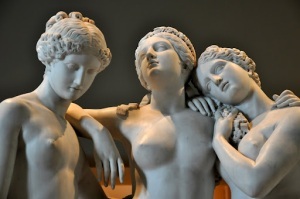 Three of the Holy Nine, from a statue in the Louvre
Three of the Holy Nine, from a statue in the LouvreBut Isis’ connection with the gift of speech and with potent words did not come out of the blue. Like most later expressions of Her nature, they found an antecedent in the Egyptian worship of the Goddess.
I hardly need to mention that Isis is preeminently the Lady of Words of Power—and words are what Aesop is lacking. As Goddess of Magic, Isis “recited formulae with the magical power of Her mouth, being skilled of tongue and never halting for a word, being perfect in command and word…” In the Egyptian Delta city of Busiris (a cult center for Osiris and famous in later times for an elaborate Festival of Isis), Isis was known as Djedet Weret, the Great Word. Thus She is the Goddess Who powerfully speaks the Words and She is the Word Itself. If anybody could do it, She would be the one Who could make the
 A Roman fresco of a priestess of Isis
A Roman fresco of a priestess of Isismute speak!
Later tradition has Isis, along with Thoth, involved with words as the inventor of writing, both hieroglyphic and demotic. The Cairo calendar calls our Goddess “the provider of the book.” The Oxyrhynchus Invocation of Isis names Her as skilled in writing and calculations. Even later, Medieval tradition considered Her a culture bearer and credited Isis with teaching the Egyptians to write.
Isis’ connection with the Muses seems to have been something widely understood at the time of the creation of the Romance. Plutarch mentions in his essay On Isis and Osiris that the leader of the Muses at Hermopolis is called both Isis and Justice. It has been suggested that the “Muses” at Hermopolis might have originally been the Egyptian Seven Hathors—plus Isis-Hathor and Isis-Ma’et (as Justice) to make the canonical nine.
And the moral of this little fable? Isis can show up anywhere—even where you didn’t expect to find Her…like hanging out with the Boy Who Cried Wolf and the Tortoise and the Hare.
__ATA.cmd.push(function() { __ATA.initDynamicSlot({ id: 'atatags-26942-6293a854b1e7b', location: 120, formFactor: '001', label: { text: 'Advertisements', }, creative: { reportAd: { text: 'Report this ad', }, privacySettings: { text: 'Privacy', } } }); });May 22, 2022
Asking Isis for Guidance
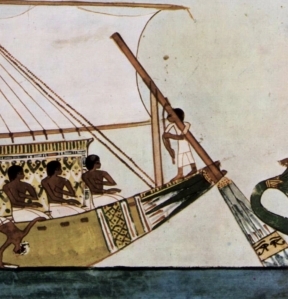 An Egyptian rudder with seeing eyes and regenerative lotus decoration
An Egyptian rudder with seeing eyes and regenerative lotus decorationPreviously, we talked about how we might experience Isis’ response to us when we ask for Her presence through our invocations, meditations, or other rites. This time, let’s look at one of the (many) reasons we might request Her presence: to ask for Her guidance in some aspect of our lives.
Divine guidance and assistance are among the most common reasons we seek out contact with our Deities. Naturally, this applies to Isis devotees as well. Indeed, Her people have always come to Her for such guidance. When seeking such guidance, one of the ways we could do this would be to employ a symbol of the aid we’re requesting. In this case, we might use one of Her important, but more obscure, symbols that is emblematic of Her guidance in our lives. It is the rudder.
Unless you are someone who spends a lot of time on the water, you might not be very familiar with the vital importance of rudders. Not so with the ancient Egyptians. As a river-dependent civilization, ancient Egypt was quite familiar with the rudders used to steer boats. It is perhaps no great leap to see the guiding rudder as a symbol of the greater guidance of the Divine.
 Illustration of an Egyptian barque with two rudders/steering oars
Illustration of an Egyptian barque with two rudders/steering oarsJust as Egyptian pilots steered their earthly boats with these rudders, so they became a symbol of guidance and direction in the afterlife. And so may we also take them as a symbol of guidance in our spiritual lives as well as our everyday lives.
In the Book of Coming Forth by Day, for example, the deceased prays that Horus, the son of Isis, will be in charge of the rudder of his funerary boat and that Thoth and Ma’et will be beside Him. In other words, he prays to be guided by the strength of Horus and the wisdom of Thoth and Ma’et.
When depicted in the funerary books, these Divine steering-oars are often decorated with the Eyes of Horus, representing the power of the Sun and Moon, and the blue lotuses of rebirth. In a group of four, the oars represent the four cardinal directions.
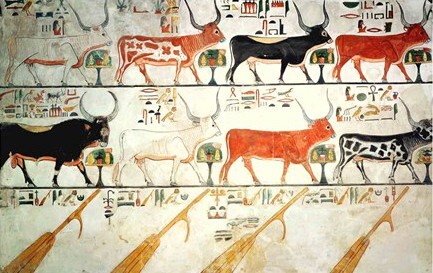 The seven Cows of Heaven and Their Bull, with four rudders representing the directions
The seven Cows of Heaven and Their Bull, with four rudders representing the directionsThe rudder is also connected with the concept of abundance. In the Book of Coming Forth by Day, the deceased prays to the living Rudders of the four directions asking them to grant bread, beer, offerings, provisions, long life, prosperity, health, and joy. Furthermore, directly following this prayer to the Rudders is the formula of the Divine Cows and Their Bull. It, too, has to do with provisions in the afterlife, as well as rebirth from the Divine Cow. The proximity of the formulae of the Divine Rudders and the Divine Bovines, as well as their similar subject matter, indicates a relationship between them. Not only do both have to do with abundance and life, but also, like the four Rudders, the four legs of the Divine Cow we sometimes associated with the four directions.
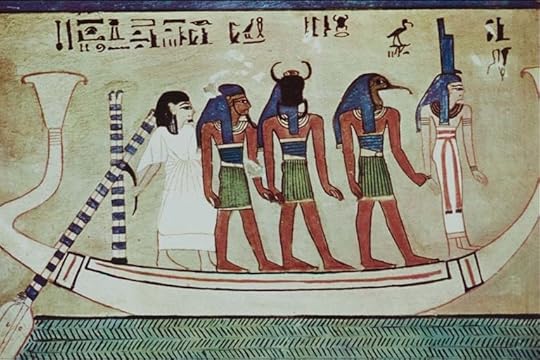 Under the guidance of Isis, the deceased steers the Boat of the Night as it passes through the Duat
Under the guidance of Isis, the deceased steers the Boat of the Night as it passes through the DuatBoth cow and rudder are, in turn, related to Isis. She is the Divine Cow Who gives abundance and rebirth and She is also a Goddess Who guides. In Egyptian texts, Isis is one of the Deities Who guides the Sun God’s boat. In later Graeco-Roman sources, Isis is specifically connected with the symbol of the guiding rudder. As Isis Pelagia, Isis of the Sea, the Goddess was known to steer the ship of life with Her sacred rudder. Mariners of all kinds invoked Her guidance and protection as they crossed the Mediterranean, braving its many dangers.
 Tyche of Antioch with Her city walls crown
Tyche of Antioch with Her city walls crownIn the Mediterranean world, the symbolism of the rudder continued to embrace the ideas of abundance and prosperity. In Hellenic lands, the rudder was a symbol of Agathe Tyche (“Good Fortune”). In Rome, it was the emblem of the Goddess Fortuna—and both Goddesses were intimately connected with Isis. In fact, of all the Goddesses in the areas influenced by Greece and Rome, Isis was the one Deity with Whom Agathe Tyche and Fortuna were most consistently assimilated.
As Agathe Tyche, Isis was considered the “luck” of a number of port cities, particularly Alexandria. In fact, Her headdress emphasizes her connection with cities. As guardian of cities, Tyche wears an elaborate crown shaped like city walls. Legend had it that Tyche gave birth to a Divine figure called Isityche Who was said to symbolize the combination of Divine Providence and Chance. As you can easily see, Isityche is none other than Isis-Tyche. In this combined Divine figure, “Isis” represents the wise guidance of the Divine, while “Tyche”—sometimes depicted as blind—represents unseeing Chance.
 Isis-Fortuna with rudder and cornucopia
Isis-Fortuna with rudder and cornucopiaThe Roman version of Agathe Tyche was the Goddess Fortuna. She was extremely popular throughout the Roman world. Every Roman emperor kept an image of Fortuna in his sleeping quarters in hopes of bringing good fortune to his reign. Anyone with particularly good or bad luck was said to have their own “Fortuna.” Fortuna even had Her own oracular shrines. Her symbols include the Wheel of Fate, a sphere representing the World that She rules, the cornucopia of plenty, and a rudder with which She steers Fate. When Fortuna is depicted specifically as Isis Fortuna, She also wears the horns and disk crown of the abundant Egyptian Cow Goddess; thus reuniting the Egyptian symbols of cow and rudder in the figure of the Goddess Isis.
Like Tyche, Fortuna was often said to be blind. And, in fact, it may have been precisely because of this that Isis became so strongly tied to both Tyche and Fortuna. The Goddess Isis was well known to be the very opposite of blind. She is specifically a Goddess Who sees and understands the needs of Her worshippers. By invoking not just blind Tyche or blind Fortuna, but Isis Tyche and Isis Fortuna, one was invoking a seeing Fate—a more auspicious Fate steered by a skillful Mistress of the Rudder, the wise Goddess Isis.
 Isis Fortuna with rudder and cornucopia, from the Temple of Isis, Pompeii
Isis Fortuna with rudder and cornucopia, from the Temple of Isis, PompeiiAnd so I give you the Isiac symbol of the rudder. Whether as the Divine Cow Goddess Who gives provisions and rebirth or as the guiding Goddess of the rudder and the cornucopia, Isis goes before us, guiding and leading us to abundance in all things. May She bless us. May She steer us toward that which we most desire. May She help us grow in strength and beauty of soul.
Amma, Iset.
__ATA.cmd.push(function() { __ATA.initDynamicSlot({ id: 'atatags-26942-628aa5a8a2f6e', location: 120, formFactor: '001', label: { text: 'Advertisements', }, creative: { reportAd: { text: 'Report this ad', }, privacySettings: { text: 'Privacy', } } }); });May 15, 2022
The Blood of Isis
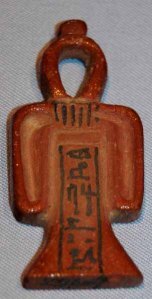 The Blood of Isis amulet
The Blood of Isis amuletI have been thinking about things related to human biology (and rights) lately. You, too? Frankly, I am terrified. You, too? I hope so. We all must get motivated and we must work and we must vote.
Of course, Our Lady Isis has always been concerned with human biology. Indeed—as are so many of our Divine Ones—She is among the “fertility Goddesses.” One of Her principle symbols has what we may consider a biological connection, too. The Tiet (also Tyet or Tet) is often known as the Blood of Isis (also the Girdle of Isis, Buckle of Isis, or Knot of Isis) and it is connected with a very particular type of blood.
It is that connection, and that blood, that I want to address today.
Appropriately, the Tiet was often made of blood-red jasper, carnelian, or even red glass. (Red glass, by the way, is a precious material and quite difficult to make; the red color comes from the addition of gold to the molten glass.)
When paired with the Djed of Osiris, the Tiet can be seen as the feminine symbol of the Goddess’ womb just as the Djed can be seen as the masculine symbol of the God’s phallus.
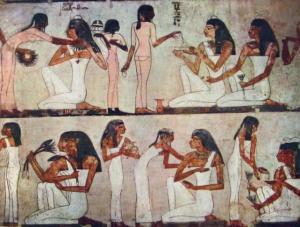 Women and girls preparing for a banquet from the Tomb of Rekhmire
Women and girls preparing for a banquet from the Tomb of RekhmireThe redness of the Tiet could represent the red lifeblood a mother sheds while giving birth. On the other hand, it might also represent menstrual blood. Some say the amulet is shaped like the cloth worn by ancient Egyptian women during menstruation. Others have interpreted it as a representation of a ritual tampon that could be inserted in the vagina to prevent miscarriage. In this case, it would have been the amulet Isis used to protect Horus while He was still within Her womb. For a whole post on the Knot of Isis, go here.
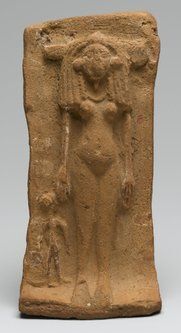 Images of a woman and child lying on a model bed have been found in home shrines
Images of a woman and child lying on a model bed have been found in home shrinesIn ancient Egypt, the red blood of menstruation is hesmen. A menstruating woman is a hesmenet. If the interpretation of the Knot of Isis as a menstrual cloth or tampon is correct, we may be well within our rights to consider Isis as the patroness of women during their monthly menstruation as well as a special patroness of women during the fertile period of their lives, this is, while they are still menstruating regularly.
A young woman’s first menstruation is a sign that she is now mature enough to become pregnant, thus the ancient Egyptians considered menstrual blood to be very potent.
One of the methods a woman might use to encourage her own pregnancy was to rub menstrual blood on her thighs. The Ebers papyrus notes that the blood of a young woman whose menses have just come could be rubbed on the breasts, belly, and thighs of a woman whose breasts were too full of milk, “then the flow cannot be to her disadvantage.” Menstrual blood might also be used to anoint infants to protect them from evil. Could it be that the Tiet amulet was developed as a more convenient way to protect children, and by extension adults, from harm through the potent protective magic of the menstrual Blood of Isis?
We have very little from ancient Egypt about women’s menstrual customs. There is one precious mention on an ostracon (a piece of pottery used as a writing surface) that scholars believe originated in Deir el-Medina, the workers’ village outside the Valley of the Kings. It says,
Year 9, fourth month of Inundation, day 13. Day that the eight women came outside [to the] place of women, when they were menstruating. They got as far as the back of the house which […long gap…] the three walls …
From this reference, scholars infer that ancient Egyptian women, like many women throughout the ancient world (as well as some in the modern world) separated themselves from the rest of the village during their menstrual periods and went to “the place of women.” What’s more, at least eight women from this village were on the same cycle. But why was this common, monthly event significant enough for someone to write it down? As far as I can tell, no one has a guess.
 The Tiet and the Djed, symbols of Isis and Osiris
The Tiet and the Djed, symbols of Isis and OsirisNone of these “places of women” have been found for certain, though there are several small structures on the outskirts of Deir el-Medina that could possibly fit the bill. Interestingly, at Deir el-Medina, the menstruation of wives or daughters is sometimes given as a reason for the man’s absence from work. The weird thing about this is that, if a man could be absent every time a wife or daughter had her period, he’d be absent at least two extra days per month…and we don’t find that many absences recorded. This has led some researchers to suggest that only in exceptional cases, for example if the woman was incapacitated by her period, could the man be absent to take care of the regular household chores.
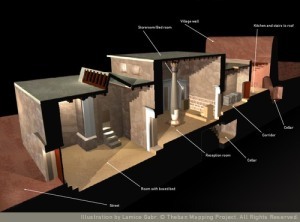 Model of a home at Deir el-Medina; looks pretty pleasant
Model of a home at Deir el-Medina; looks pretty pleasantThe other reference to a place of menstruation comes from much later—in the Ptolemaic period—when we find a reference to a “place beneath the stairs,” actually within the home, as the place of menstruation. This room must have been reasonably common for we find reference to it in a number of documents related to the sale or purchase of a home. I am imagining some ancient realtor noting the lovely little “place beneath the stairs” as a selling feature of the house. (It should be noted that a woman was the seller in at least one of these real estate transactions and in another, a woman was the buyer; more evidence of women’s relatively high status in Egypt.)
In a house in Amarna, in just such a place beneath the stairs, archeologists found two model beds made of clay, parts of two female figurines, and a stela depicting a woman wearing a cone on her head while leading a young girl before the Goddess Taweret. That all seems pretty clear to me; this is where women go to menstruate and where they celebrate the coming of age of young women, who are being introduced to Taweret, the hippopotamus-form Goddess of pregnancy and childbirth.
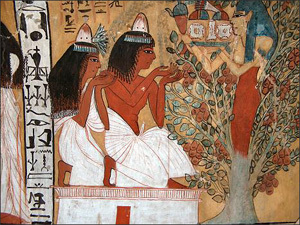 Egyptian woman and man taking food & drink from the Tree Goddess in the Otherworld
Egyptian woman and man taking food & drink from the Tree Goddess in the OtherworldThese special places for menstruating women seem to indicate a taboo around menstruation; the women absented themselves from the village or stayed in a special room. We also have lists of bwt, prohibitions or “evil”, in the 42 Egyptian nomes and some of them include menstruation and menstruating women—along with things like a black bull, a heart, and a head. We’re not sure in what way any of these things were to be prohibited; perhaps by keeping them out of the nome? At any rate, menstruation in these cases was seen as something negative.
There does not seem to have been a notion of actual pollution around menstruation or menstruating women, however. Contact with a menstruating woman was not dangerous to a man, even though she was bwt in some nomes. In fact, some scholars think it was the menstruating woman who needed protection during her period. Thus, in the case of the absent workers of Deir el-Medina, the workers stayed away from the death-touched tombs in which they were working in order to protect their menstruating female relatives. Conversely, the Egyptians may have wanted to prevent the non-pregnancy/fertility of a menstruating woman from touching the cosmic womb of the royal tomb through her male relative, and thus rendering it magically ineffective.
 “Isis” by Georges Lacombe, 1895; from Her breasts blood, rather than milk, flows to nurture flowers
“Isis” by Georges Lacombe, 1895; from Her breasts blood, rather than milk, flows to nurture flowersInterestingly, it may be that menstruation was also associated with cleansing. Hesmen is not only the word for “menstruation,” but is also found with the meaning “purification.” It was also a term for the ritual cleanser par excellence, natron.
From the evidence, menstruation in ancient Egypt had both positive and negative connotations. On the one hand, it was a sign that a woman could become pregnant—something most women desired—and it was used as a potent protection or cure. On the other hand, if one was menstruating, one was clearly not pregnant at the time, so menstruation might be incompatible with work on the magical womb of the tomb, which must be kept fertile at all times.
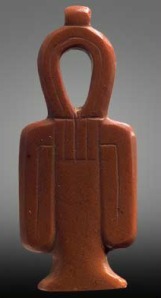 May the Blood of Isis protect you
May the Blood of Isis protect youMany women might agree with this ambivalent attitude toward their periods. Having a period is at once a beautiful confirmation of connection with the cycles of Nature and the Great Goddess, and it can be a painful and messy time, too. In whatever way we are currently experiencing those cycles, we can be sure that the protection, as well as the shared female experience, of the Holy Blood of Isis is with us.
May 8, 2022
Talking with Isis
 A meditation on beautiful Sirius, the Star of Isis
A meditation on beautiful Sirius, the Star of IsisWhen we connect with Isis, how do we do that? Prayer? Meditation? Invocation? Visualization? Can we talk with Her, actually have a back-and-forth conversation? Can we ask Her questions? Can we request Her help?
Yes, we can. How exactly you do it is up to you. I believe it will be more important than ever for all of us to connect with our Divine Ones during the coming days and years. Life is not being easy or simple right now…if it ever really is.
For me, the boundaries between prayer, meditation, and visualization tend to be rather soft. Very often, I find that meditation flows into visualization flows into prayer flows into an offering chant flows back into meditation. Sometimes I visualize the whole time, sometimes I don’t “see” anything, but just feel Her presence. Sometimes I can “hear” Her voice, sometimes I just sense in some way what She is communicating with me. I have taught myself to be able to stay entranced and still take notes when it’s important that I remember the experience…or what She said exactly.

Here’s a perfect image for ‘ascending’ in your visualizations…indeed, the pillars in Egyptian temples were meant to be holding up the sky.
But why do we talk with the Goddess, why do we strive to “see” Her? There is a point and it’s not just an ego boost.
The point of this sort of talking with the Goddess is communion—sharing with Her in one way or another and asking Her to share with us. Sometimes we just need the reassurance that She is there, so we invoke and try to sense Her. Sometimes we need help, so we ask for it. Sometimes we are so full of love for Her that we simply must express it.
 An excellent posture for meditation
An excellent posture for meditationTalking with Goddess is good for our souls and spirits, too. I think that Iamblichus, my favorite Neoplatonic theurgist, had it right: invocation of the Deities lifts up the soul of the theurgist (or Isis devotee, in this case) and brings us closer to the Divine. By repeatedly connecting with Isis—whether through prayer or ritual or devotions, meditations or visualizations, dance or chanting, or any number of other ways—we make ongoing contact with the Divine.
The more we come into the presence of Holy Isis, the more we become infused with Her holiness. In the same way that we tend to mirror the people with whom we spend the most time, spending more time with the Divine can help us better mirror that Divinity, and can help to make us better people.
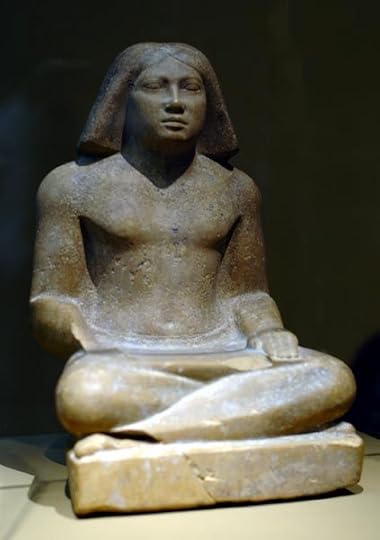 This classic scribe’s posture is perfect for meditation, too
This classic scribe’s posture is perfect for meditation, tooOf course there are ways we can make some serious missteps in this process. The most problematic is when we think we’re talking to Isis, but we’re actually talking to ourselves; when it’s not Isis Who we hear in our heads, but only our own subconscious echoes.
That’s what I think happens with some of the mega-church preachers who always seem to hear God asking for more money or with church-based hate groups who think they hear God condemning everyone but themselves. They’re not talking to the Divine; they’re getting feedback from their own interior bullshit. This can happen to people with even the best of intentions. I know it’s happened to me; chances are, if you’re talking with Isis, it will or already has happened to you, too.
So what do we do about it?
 Sometimes, vision looks like this…
Sometimes, vision looks like this…Unfortunately, there’s no easy answer, no perfect solution, no quick fix. The only partial answer that I know of is to develop spiritual maturity. A spiritually mature person will be better able to recognize their own internal “stuff,” and so be better able to separate it from true Divine contact with Isis. Did Isis really say that so-and-so with whom I had a fight yesterday deserved a big, fat comeuppance? Nope; pretty sure that was me and not Her. She, on the other hand, might offer advice on how I can get over it or She might even point out that I need to make an apology.
The other tricky thing about all this is that while we live in these bodies, we will never—I repeat, never—receive pure and unadulterated contact with the Divine. It comes to us though our own perceptions of body and mind. There is no other path the Divine can use. While we are incarnate beings, the Goddess must come to us through our perceptions—and our perceptions are always, always, always tinged by our own psychological makeup. That’s not necessarily a bad thing. In fact, getting to know our own psychology is very valuable in sorting all this out. It’s just something that is and we have to be aware of it if we hope to hear—in the clearest voice possible—what Isis has to say.
 …or like this
…or like thisThe one clue I can offer, after many years of wrestling with my own head and heart and psyche, is that when it is truly Her—as opposed to just my echo chamber—the thought-impression-words-feeling-intuition I get comes to me quickly and easily, and often (seemingly) “out of the blue.” I can recognize the communication as “not-me” (or not just me, more accurately). Sometimes the words are strange and poetic…or the images that come with the message are not ones I would normally formulate myself. If I am in mental conversation with Her, the words flow and I don’t struggle to understand the content of what She says, though sometimes the precise meaning takes meditation to unravel.
Yes. This is all very subjective. And that is my point exactly: we are always in the mix. That’s why the more we know about ourselves, the more we can move ourselves out of the way so that we can better know when it is Isis Who is doing the talking.
__ATA.cmd.push(function() { __ATA.initDynamicSlot({ id: 'atatags-26942-627872475e62d', location: 120, formFactor: '001', label: { text: 'Advertisements', }, creative: { reportAd: { text: 'Report this ad', }, privacySettings: { text: 'Privacy', } } }); });


